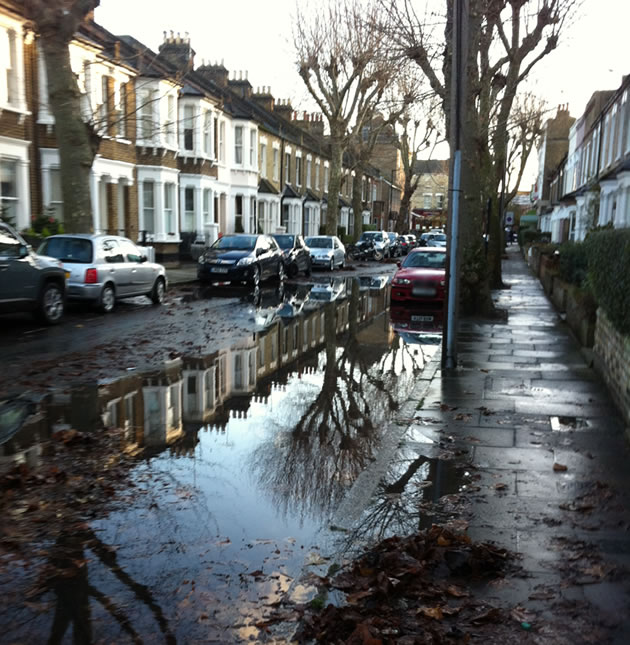Interruptions to Chiswick's Water Supply Predicted to Increase
Underinvestment by Thames Water means leaks and burst mains could accelerate

Picture: Thames Water
|
Chronic underinvestment by Thames Water is believed to be the root cause of the major water main bursts seen over the last week which have led to the supplies of thousands of people in Chiswick being cut off. An internal review into Thames Water’s network suggests these incidents are not likely to be one offs and interruptions to the water supply will become increasingly regular.
A burst water main in Goldhawk Road on 31 January was the third incident in five days in which issues with Thames Water’s pipes caused chaos and disruption the area. In Chiswick schools and businesses were forced to close whilst in Shepherd’s Bush and Hammersmith major flooding has forced people to leave their homes. The detection of a leak in the early hours of Friday 26 January required the closure of the North Circular north bound for three days between Chiswick Roundabout and Gunnersbury Lane and, later that day, a burst main caused substantial flooding on King Street near Ravenscourt Park. In December of last year Chiswick High Road was flooded by a major leak near the site of the former Carvosso's restaurant.
Thames Water has the worst record on leakage of any of the privatised water companies losing a quarter of the water pumped into the system according to Ofwat. An internal report into the Thames Water network has been released to the public and it shows that the rate of burst pipes is increasing, with a Freedom on Information request by the Evening Standard revealing that Thames Water was called out to fix over 5,000 leaks in the year to April 2017 an increase of 26%
The internal review into Thames Water’s operation by Paul Cuttill, the former Chief Operating Officer of EDF Power Networks shows that Thames Water plans for just 300 bursts a year over its 3000km network of pipes with 60 of those ruptures on pipes of over 18-inches. However, the rate of leakages and burst already substantially exceeds that and the maintenance and replacement schedule is too slow to enable any improvement. According to the Financial Times, in the year to February 2017 the company had planned to replace 26km of trunk mains but only did the work on 9.4km. The review into the company’s performance said that the annual replacement rate of 0.19% was “not keeping pace with deterioration” and it would take 357 years to upgrade the network at the current rate. The lifespan of the pipes is around 50 years. Japan replaces its water pipes every 10 years, 38% of the network in London was built before 1930. However, Thames Water’s claim that it is struggling with an ageing Victorian era pipe network does not give the full picture. Leaks and bursts on pipes installed after 2000 are just as common on those on the infrastructure inherited by Thames Water and the report states no “specific vintage of pipe was prone to failure”.

Flooding in the centre of Chiswick last December
A Thames Water spokesman told the FT, “For us to reline our trunk mains every 10 years, it would be 300km a year and cost anything from £0.5bn to £1.5bn a year.” Thames are currently spending about £100million a year on upgrades and maintenance, about the same as the dividend they pay out.
The report concluded that Thames Water had a shortage of out of hours staff to respond to emergencies and no clear claims process for those affected by flooding. Thames Water announced that they were holding a strategic review in October 2017 in an attempt to improve their maintenance performance. They have set up a rapid response team to deal with incidents and hired IBM and the University of Surrey to more accurately inventory their assets.
Sir Ian Byatt, the former head of Ofwat, was quoted by the FT as saying, “Thames Water has been telling a good story that’s all it is. Whether or not it’s a 19th century main, Thames has failed to fix the network. They’ve been far too concentrated on profits and it’s just no way for a monopoly water supplier to behave.” He called on the company to lose its licence unless ‘rapid and radical reform’ was delivered.
In response Thames said that reducing leaks was their priority and that they were set to spend over £240mn relining and replacing trunk mains in the five years up to 2020. They claim to have invested £1bn per annum in total in the network over the last 11 years and that the level of leakages has been consistently below that set out in their commitments to the regulator.
Thames Water is owned by Kemble Water Holdings Ltd, a consortium of domestic and international investors with the Canadian pensions group OMERs holding the largest stake. Other shareholders include the BT Pension Scheme, the Abu Dhabi Investment Authority, the China Investment Corporation and the Kuwait Investment Authority.
Ofwat, the industry regulator, measures the quality of service provided by companies to their household customers and Thames Water has the lowest score of any of the water companies.
February 4, 2018